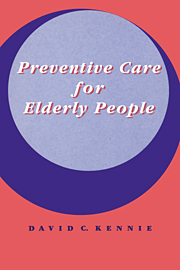Book contents
- Frontmatter
- Contents
- Acknowledgements
- 1 An overall perspective
- 2 What is health in old age?
- 3 The goals of health promotion for elderly people
- 4 A task for everyone
- 5 Critique of strategies
- 6 Cancer prevention
- 7 The prevention of non-cancerous health problems
- 8 Enhancing functional status
- 9 Strengthening support systems
- 10 Summary of problems and strategies
- 11 Tailoring strategies to individuals
- 12 Targeting, screening and surveillance in primary care
- 13 Practical aspects of implementation
- 14 The costs of preventive care and health promotion
- Index
8 - Enhancing functional status
Published online by Cambridge University Press: 15 October 2009
- Frontmatter
- Contents
- Acknowledgements
- 1 An overall perspective
- 2 What is health in old age?
- 3 The goals of health promotion for elderly people
- 4 A task for everyone
- 5 Critique of strategies
- 6 Cancer prevention
- 7 The prevention of non-cancerous health problems
- 8 Enhancing functional status
- 9 Strengthening support systems
- 10 Summary of problems and strategies
- 11 Tailoring strategies to individuals
- 12 Targeting, screening and surveillance in primary care
- 13 Practical aspects of implementation
- 14 The costs of preventive care and health promotion
- Index
Summary
General deconditioning with age
Importance
In the adult years, activity is at its highest in the twenties and thirties. Thereafter, activity levels decline as energetic leisure time pursuits are abandoned. These levels then remain stable until retirement, when a second major decline in activity occurs. There is evidence that a significant proportion of the changes commonly ascribed to the ageing process are, in fact, the biological consequences of this inactivity and disuse. Foremost amongst these changes is cardiovascular deconditioning as manifest by the maximum oxygen consumption, which declines at about 1 per cent per annum with age, but a range of other changes such as reduced red cell mass, loss of lean body mass and osteoporosis have, at least in part, been implicated as being due to disuse that occurs during ageing.
There is also increasing evidence that inactivity in later years is associated with an increased susceptibility to certain disabling disorders, such as cardiovascular disease, stroke and hip fracture, that play a major role in functional decrement. Furthermore, further deconditioning rapidly accompanies the recumbent bed rest and even non-recumbent rest that results from the frequent bouts of intercurrent illness commonly occurring in the elderly population.
Targeting/detection
It is extremely difficult to distinguish between the normal ageing process and the changes due to inactivity and disease. No reliable technique is available to identify those at particular risk of inactivity. Health promotional measures must therefore be applied to the whole of the elderly population.
- Type
- Chapter
- Information
- Preventive Care for Elderly People , pp. 171 - 216Publisher: Cambridge University PressPrint publication year: 1993



